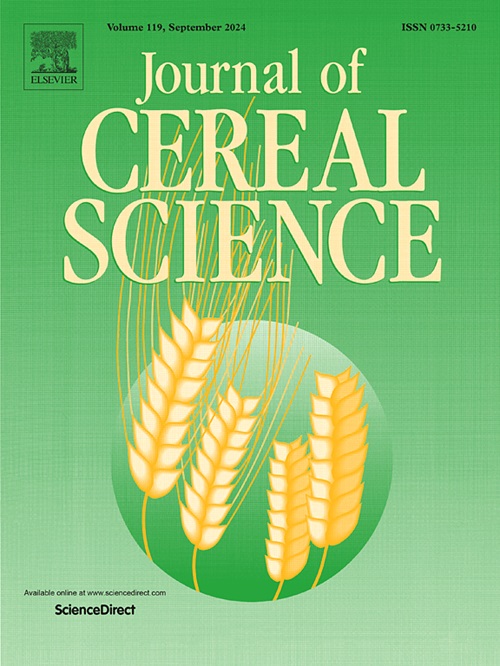Distribution of polyamines in kernel tissues of Canadian barley cultivars and their association with protein content
IF 3.7
2区 农林科学
Q2 FOOD SCIENCE & TECHNOLOGY
引用次数: 0
Abstract
Polyamines are nitrogen-containing compounds that naturally occur in barley grain and are known to have beneficial effects on human health. This study investigated the distribution of polyamines in barley grains from two covered and two naked Canadian barley cultivars. Five pearling fractions were collected at 5 % intervals of kernel weight for all cultivars. Grains from covered cultivars were dehulled before pearling, followed by consecutive sieving to recover the germ, fine hull (<0.5 mm), and coarse hull (>0.5 mm) fractions. The levels of putrescine, spermidine, and spermine in barley kernels with 25 % kernel weight removed were 69–76, 55–64, and 21–41 % lower than those in unpearled kernels. Dehulled and pearled kernels were enriched in spermine and depleted in putrescine. The barley germ showed a notably high total polyamine content (52.0–65.5 mg/100 g). The protein and total polyamine content in the fine hull fraction were 2.8–3.5 and 2.1–3.3 fold higher, respectively, compared to the coarse hull fraction, reflecting differences in their histological composition as shown by microscopic examination. Correlation analysis revealed positive and significant correlations between polyamine and protein content at the sub-kernel level (r = 0.769–0.839), suggesting a potential chemical and physiological synchronization between these components during barley seed development and germination. The insights provided by this study on the obtainment of polyamine-rich fractions from barley grains could be valorized for nutraceutical purpose. The understanding about polyamine–protein relationship in barley tissues could aid the selection of cultivating or processing conditions for different uses.

加拿大大麦品种籽粒组织中多胺的分布及其与蛋白质含量的关系
多胺是天然存在于大麦谷物中的含氮化合物,已知对人体健康有益。研究了加拿大两个有盖大麦和两个裸大麦品种籽粒中多胺的分布。在粒重5%的间隔时间内,对所有品种采集了5个珠光部分。覆盖品种的籽粒在采珠前脱壳,然后连续筛分,回收胚芽、细壳(0.5 mm)和粗壳(0.5 mm)部分。除去25%粒重的大麦籽粒中腐胺、亚精胺和精胺的含量分别比未除去粒重的大麦籽粒低69 ~ 76%、55 ~ 64%和21 ~ 41%。去皮和去珠的果仁精胺含量丰富,腐胺含量减少。大麦胚芽中总多胺含量高达52.0 ~ 65.5 mg/100 g。细粒船壳中蛋白质含量和总多胺含量分别是粗粒船壳的2.8 ~ 3.5倍和2.1 ~ 3.3倍,这反映了显微检查中两者组织组成的差异。相关分析显示,多胺与蛋白质含量在亚粒水平上呈显著正相关(r = 0.769-0.839),表明在大麦种子发育和萌发过程中,多胺与蛋白质含量可能存在化学生理同步。本研究提供的关于从大麦颗粒中获得富含多胺的组分的见解可用于营养保健目的。了解大麦组织中多胺与蛋白质的关系,有助于选择不同用途的栽培或加工条件。
本文章由计算机程序翻译,如有差异,请以英文原文为准。
求助全文
约1分钟内获得全文
求助全文
来源期刊

Journal of Cereal Science
工程技术-食品科技
CiteScore
7.80
自引率
2.60%
发文量
163
审稿时长
38 days
期刊介绍:
The Journal of Cereal Science was established in 1983 to provide an International forum for the publication of original research papers of high standing covering all aspects of cereal science related to the functional and nutritional quality of cereal grains (true cereals - members of the Poaceae family and starchy pseudocereals - members of the Amaranthaceae, Chenopodiaceae and Polygonaceae families) and their products, in relation to the cereals used. The journal also publishes concise and critical review articles appraising the status and future directions of specific areas of cereal science and short communications that present news of important advances in research. The journal aims at topicality and at providing comprehensive coverage of progress in the field.
 求助内容:
求助内容: 应助结果提醒方式:
应助结果提醒方式:


